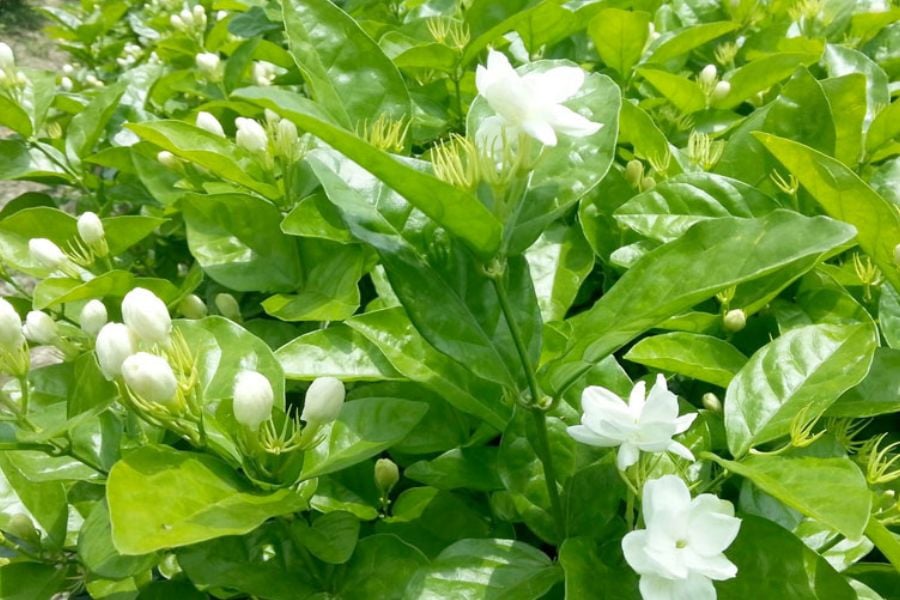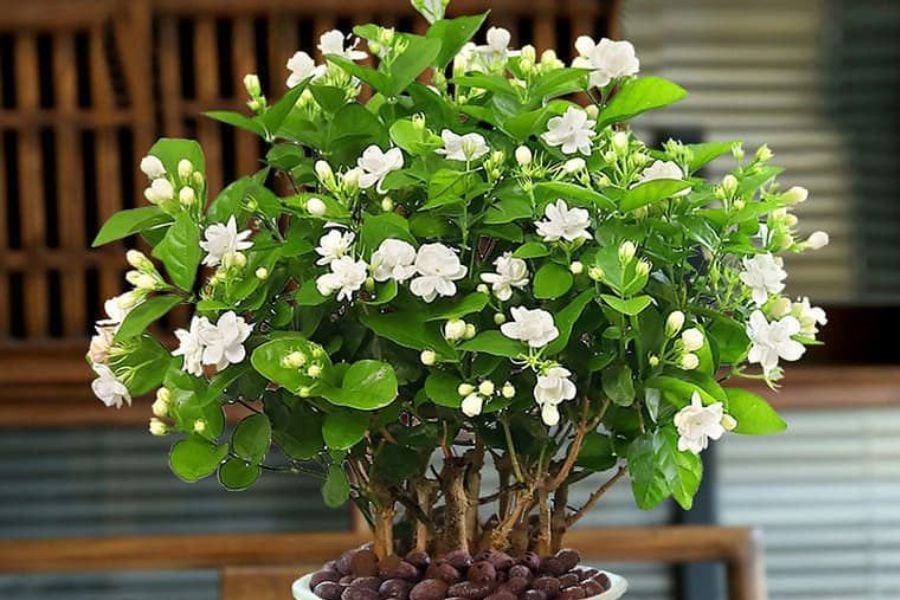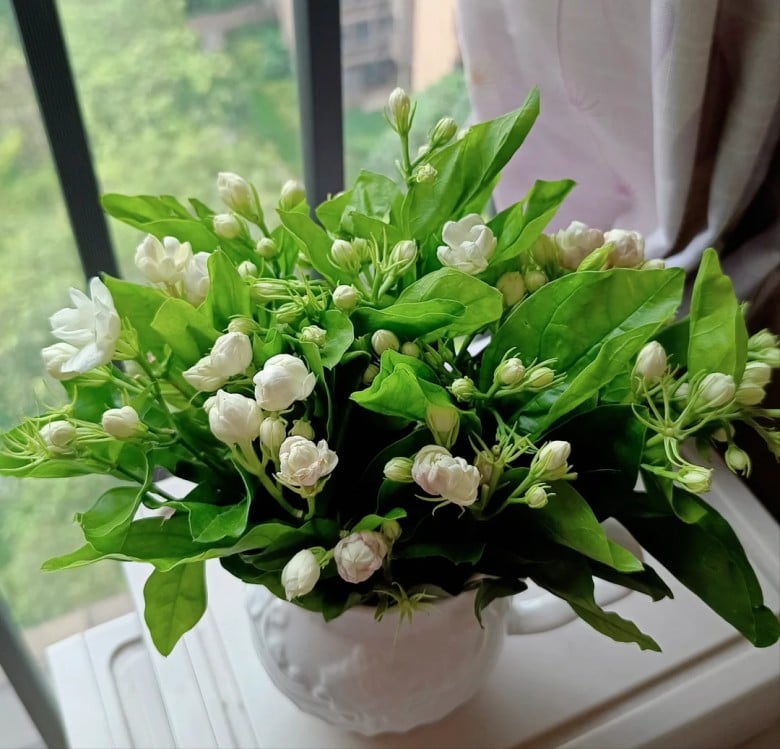Jasmine, with its sweet fragrance and elegant beauty, is a popular plant among families who wish to enhance their living spaces. Despite being easy to grow, potted jasmine at home often doesn’t bloom as profusely as those sold at flower markets. So, how can you achieve lush, fragrant, and year-round blooming jasmine plants?
To achieve vibrant jasmine plants with abundant flowers, there are some useful secrets that expert gardeners employ. Here are five notable tips to consider:
Increase Sunlight Exposure
Jasmine is a sun-loving plant, so providing ample sunlight is of utmost importance. The more sunlight it receives, the more it will bloom, and the larger and more fragrant the flowers will be. Ensure your jasmine plant gets 6 to 8 hours of natural sunlight daily.
There’s an old saying, “Jasmine doesn’t die under the sun, and chrysanthemums don’t die in the shade,” emphasizing jasmine’s preference for sunshine. Even during hot summer days, if you adequately water your jasmine, it can thrive in the sun’s embrace.
Insufficient sunlight over an extended period will result in uncontrolled branch growth and hinder bud development. Consequently, the plant will produce only a few buds, and the flowers will be of inferior quality, with fewer petals and a less intense fragrance.

Jasmine thrives in abundant sunlight, so ensure it receives plenty of sunshine.
Ensure Adequate Watering
Jasmine is a water-loving plant, and proper watering is crucial for its health. With its abundant foliage and high transpiration rate, jasmine requires frequent watering, especially during hot and sunny days.
For potted jasmine, water your plant when the soil moisture decreases by 10% to 20%. However, the soil must be well-aerated and loose to prevent root rot due to waterlogging.
When watering, combine it with misting to increase humidity. This not only makes the branches and leaves shiny but also promotes healthy and lush growth.
Provide Nutritional Supplements
All flowering plants, including jasmine, require abundant nutrition. Applying appropriate fertilizers is essential for its well-being. Organic fertilizers are preferable for jasmine, and cake fertilizers are a convenient and effective option.
For daily care, consider using the following two fertilizers to promote vigorous growth and frequent blooming:
– Mixed flower fertilizer: This multi-nutrient fertilizer can be applied periodically every 10 days. It is especially beneficial to use a bloom-boosting fertilizer before the flowering season. You can use a phosphorus-potassium mixture, diluted with water at a ratio of 1:1000 or 1:1200, and then water it at the roots or spray it on the leaves every 7 to 10 days.
– Sulfate of iron for acidic soil: Iron sulfate helps prevent root rot and leaf yellowing caused by alkaline soil, which often hinders jasmine’s growth. Mix iron sulfate with water at a ratio of 1:1000 and apply directly to the root system to encourage robust growth.
Additionally, repot your jasmine annually, preferably in the spring. When repotting, add a layer of base fertilizer to improve soil fertility. This will enhance the plant’s blooming potential.
With properly applied base fertilizer, you can reduce the frequency of fertilizer applications without compromising the plant’s growth, saving you time and effort in care.

With base fertilizer, you can reduce fertilizer applications without hindering the plant’s growth.
Prune Your Jasmine Effectively
Jasmine, with its fragrant blooms, requires special care to ensure vigorous growth and abundant flowering. One of the most effective measures is regular pruning. This encourages the formation of new branches, thereby increasing the potential for more flowers. In fact, for every properly pruned branch, at least two new branches will grow, significantly increasing the flower count.
– Pruning after flowering: After jasmine blooms fade, prune the branches reasonably. Cut back about 1-2 cm from the wilted flowers. If the branches are too long, you can also trim them to shape the plant. Remember to remove branches without buds or new shoots. Typically, pruning is done at the four leaves below the branch to encourage new, healthy growth.
If the plant becomes too dense, affecting air circulation, remove branches without buds to create space for new growth.
– Pruning newly planted jasmine: Newly purchased jasmine plants often bloom early. After this initial bloom, prune them as you would established plants. With proper pruning, you’ll soon see 2-3 new buds appearing at the top leaf pairs, setting the stage for continuous flowering.
If you spot any yellow or withered leaves or branches, prune them promptly. This not only improves airflow but also greatly benefits the plant’s growth and blooming.
– Pruning mature jasmine: For older jasmine plants with many aged branches, pruning is essential to maintain their blooming potential. Remove long branches, those deep within the canopy, or any wilted ones to give the plant a neater appearance.
With reasonable pruning, your jasmine plant will become more airy, improving its ability to absorb sunlight. It will also promote new, vibrant growth. Proper pruning not only enhances the plant’s health but also increases the number of buds and flowers during the blooming season.

Proper pruning results in a more airy plant, improving its ability to absorb sunlight and promoting new growth.
Control the Height of Your Jasmine
When strolling through flower markets, you’ll notice meticulously pruned jasmine plants with uniform, attractive buds. However, at home, many people struggle with uneven growth, varying branch heights, and small, unattractive buds.
To showcase jasmine’s beauty as an ornamental plant, it’s crucial to know how to prune it properly. This not only gives the plant a fuller, neater appearance but also allows it to absorb nutrients more effectively. When pruned correctly, the jasmine can focus its energy on blooming and receiving more sunlight, resulting in more vibrant and stunning flowers.
Regular pruning will help maintain your jasmine plant at a suitable height, neither too bushy nor scraggly. While some may consider using height control chemicals, it’s important to exercise caution. These chemicals can pollute the environment and pose health risks to your family. Instead, opt for natural pruning as a safer and more effective way to maintain the beauty of your jasmine plant.






































